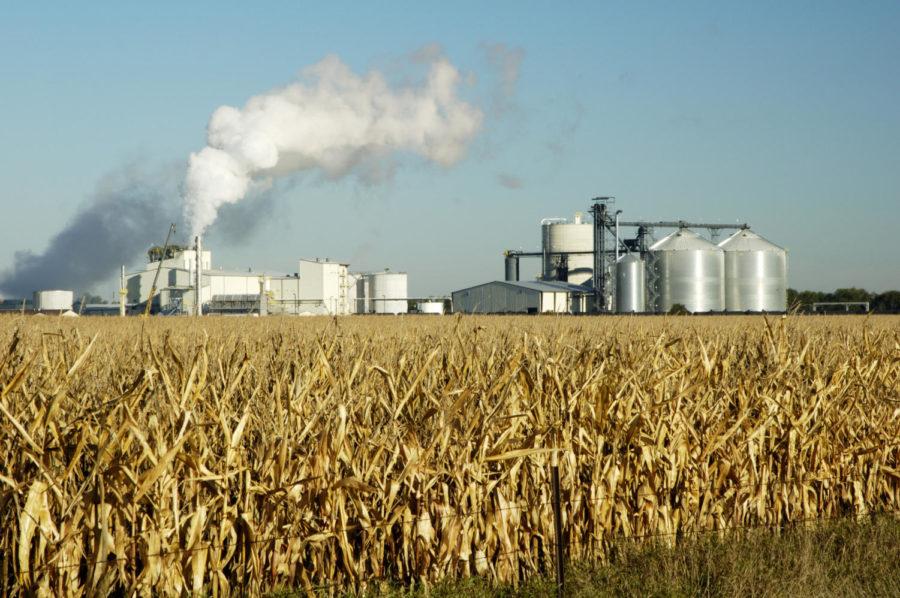Schmitt: Ethanol’s climate mitigation strategy is necessary
Courtesy of Jim via Adobe Stock
Columnist Dawson Schmitt explains why we still need corn-based ethanol. Pictured above is an ethanol production plant in South Dakota.
February 20, 2022
It isn’t easy to travel a long distance in Iowa or other Midwestern states without driving past a cornfield. It is also difficult to fill up your gas tank without seeing ethanol-blended fuel at the gas station, thanks to the 15-year-old Renewable Fuel Standard (RFS) that requires transportation fuel sold in the United States to contain a minimum volume of renewable fuels. Since the passing of the standard, ethanol has been promoted as an environmental-friendly alternative to straight gasoline in cars.
However, a recent study, published in the Proceedings of the National Academy of Sciences, attempts to debunk the long-standing claim held by the Environmental Protection Agency, California Air Resources Board and the United Nations: ethanol use is better for the environment than straight gasoline. According to the report, ethanol is at least 24% more carbon-intensive than gasoline due to emissions resulting from land-use changes to grow corn.
To back the research, one claim that the study contributes to ethanol’s bad rap is that after the passing of the Renewable Fuel Standard, acres dedicated to corn in the United States have increased. Indeed, corn acres increased from $78 million acres in 2006 to $97 million in 2012, a 24% increase. But today, national corn acres are down nearly $4 million acres since 2012. Looking at Iowa, corn acres have also decreased over the last decade, especially after seeing a significant drop in acres in 2008.
While planted acres still remained above 2006 levels, it shows that other external factors have driven planting intentions in Iowa. At the same time, yields improved, allowing producers to grow more corn on less land.
Even if land conversion resulted from ethanol blending mandates, those conversions are not happening as much. Some farmers are also seeing the benefits of enrolling acres into the Conservation Reserve Program (CRP), something that the study thinks farms should do to keep up with carbon sequestration. But the recent study’s claim for land use changes contributing to a mass release of greenhouse gases was already debunked in 2019 by Ramboll Group at the request of Growth Energy.
Crop production has also improved, where more farmers are implementing practices each year that reduce their carbon footprint and generate a larger profit, such as practices like no-till, where farmers skip cultivation to plant crops in fields with leftover residue. The practice is known for decreasing soil erosion and promoting soil health which mitigates greenhouse gases.
Still, larger, anti-agriculture new sites such as Civil Eats regurgitate the study’s claims, attempting to correlate declining CRP numbers to higher commodity prices. It’s true that CRP numbers have declined over the last 25 years, but, as I’ve stated earlier, farmers are using practices that help prevent soil erosion, a goal that CRP attempts to accomplish. Bringing land out of CRP does not necessarily mean farmers are going back to degrading the soil. Furthermore, prices spiked again in 2012, as Civil Eat’s chart shows; that was due to severe drought that affected crops around the U.S., tightening supplies.
Prices were doing really well, yet, the next year, data from the United State Department of Agriculture showed that corn acres decreased. Again, it shows that many factors contribute to what crop farmers plant and how they plant it. Much of what supporting arguments that ethanol is worse for the environment do not tell the full story. Here is what we know from past studies: ethanol’s greenhouse gas impact is about 39% lower than gasoline, including in the production stage.
Right now, biofuels are the best strategy to mitigate climate change in terms of transportation fuel. Production practices will continue to improve and use less land. So why is corn-based ethanol currently worth the investment? It is because it is a tool we currently have. Iowa needs to continue investing in future energy technologies that may be better than renewable fuels, but why not work with what we currently have that is proven to help achieve the climate goal?

















